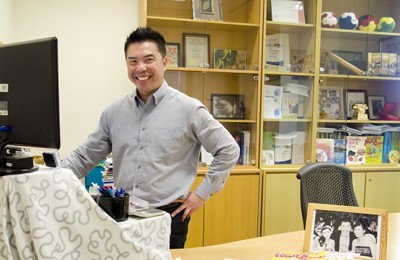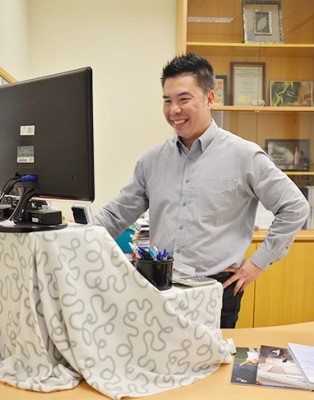Why Singapore’s English Teachers Should Embrace Singlish, Not Fight It
Is it time for Singaporean educators to embrace Singlish as a legitimate learning tool? What the Research […]
Read More
The harmful effects of smoking are well established – but did you know that sitting for prolonged periods can be just as dangerous, and affects an even larger group of people? Professor Michael Chia stands, fidgets frequently and shares how he is constantly working to combat our modern sedentary lifestyle through education and research.
When Professor Michael Chia first shared with SingTeach about his project PRIDE for PLAY (Personal Responsibility in Daily Effort for Play for Participation in Lifelong Activity for Youths) in 2008, he aimed to introduce a daily dose of physical activity, or play, in students’ lives.
Play is an essential part of a holistic education. It not only keeps students healthy, but also provides a balance to the amount of time they spend on reading, writing or working at the computer (near-work).
Play is a pre-requisite for many of the good things in life. Prof Chia also said that play can help build interpersonal relationships among students and teachers, who get to interact in an informal setting.
This is also central to NIE’s thrust to imbibe positive values and build a resilient culture and character among youth through PE and sport – attributes that are relevant to ensuring that Singapore remains a special place on Earth in the next 50 years.
Four primary schools and two secondary schools took part in the project, and results showed a boost in the students’ morale without any negative effects on their academic results. Jurongville Secondary School found the results encouraging and is continuing with PRIDE for PLAY, in its own context in the school curriculum.
“It’s heartening to see the project being sustained, and now the school owns PRIDE for PLAY,” Prof Chia shares. “It can serve many purposes, but I emphasized that the school has to decide on their main purpose and how PRIDE for PLAY (PfP) can act as an affordance.”
Prof Chia’s work has now evolved beyond making time for students to get active in school. Along the same vein, he is now working to educate both students and adults alike about the hidden dangers of a sedentary lifestyle.
In jest, he likens prolonged sitting to “a cruel and unusual punishment” and encourage an ecosystem where everyone makes the choice to lead a healthier lifestyle by sitting less and breaking up prolonged periods of sitting. It is important to empower the young and the not-so-young with options where they can choose to be less sedentary throughout the day.

In Singapore, about 15% of the adult population who smoke are exposed to the negative health impact of inhaling harmful chemicals, whereas almost everyone is exposed to the dangers of prolonged sitting. For instance, Singaporean adolescents are physically inactive 90% of the time.
Prof Chia shares a scary but eye-opening fact: While smoking one cigarette shortens your lifespan by 11 minutes (Shaw, Mitchell & Dorling, 2000), 1 hour of sitting shortens it by 22 minutes (Veerman et al., 2012)!
In a recent keynote, Prof Chia shared about the European Prospective Investigation into Cancer and Nutrition (EPIC) study, which followed over 334,000 European men and women over a period of 12 years and found a link between physical inactivity and premature death.
From there, researchers estimated that 337,000 of the 9.2 million recent deaths amongst Europeans were caused by obesity; even more alarming was that the double of that number of deaths (676,000) could be attributed to physical inactivity (University of Cambridge, 2015).
In a submitted commentary article to a European journal where the piece waswritten while he was standing and fidgeting), Prof Chia notes that not many people are aware of this. If you were to do an online search for “exercise physiology”, you get more than 12 times the number of articles of that for “sedentary or inactivity physiology”.
“We’ve been promoting sports a lot and we know a lot about sports, but the number of people who are very active remains relatively low compared to those who remain physically inactive on most days of the week, months and years,” says Prof Chia. “What about the other big group of people? We must address the elephant in the room.”
This is why Prof Chia has decided to make it his mission to educate as many people as possible. More importantly, after raising awareness, he wants to pose this question: “Now that you know this, there is a lot that you could in small ways to change your lifestyle.”
Prof Chia hopes that when people are informed, they will be more discerning and exercise (pun intended) their free choice in their daily lives to sit less and move about more. But for people who choose to be active, their environment has to allow for it.
“We need an ecosystem where your whole environment is activity-enabled. I’m not just talking about sports facilities, but also allowing for healthier options in the office, classroom or even canteen.”
This ecosystem must be all pervasive – more active options for transport, for rest, leisure and enjoyment, and even at home. Prof Chia acknowledges that many useful and important tasks are accomplished whilst seated. Even our daily vocabulary is rife with phrases such as “sitting for examinations” and “parliament sitting”.
Large segments of society accept that prolonged sitting in society is a hard habit to break but Prof Chia advocates that starting small and smart can mean that the changes will be sustained in time to come.

Prof Chia decided to start small, and start in his immediate surroundings. During two conference keynotes that he delivered recently, he flashed a “just-in-time” prompt on the screen every 15 minutes, and observed conference participants’ behaviour.
The simple prompt read: “Research informs us that prolonged sitting harms. Please be free not to sit at this presentation! 1 cigarette = minus 11 minutes of life. 1 hour of sitting = minus 22 minutes of life.”
This exercise does not entail much work or costs and still raises awareness and reminds the participants to do something on the spot. He is encouraged by his observations, especially when the prompts come in the latter part of the day.
Prof Chia hopes to work with the National Healthcare Group (NHG) to display the prompt in their workshops to reduce prolonged sitting.
As he believes in creating an ecosystem, Prof Chia also has suggested that the prompts can be placed in offices, meeting rooms and even canteens, and that stand-up tables can be installed so that individuals can choose to eat either sitting down or standing (Chia, Chen & Suppiah, 2015).
Prof Chia is also thinking of developing a mobile phone app that will prompt users to stand up periodically.
“What we’re after is not a structured programme to force people to stand and move about,” Prof Chia explains. “We want them to help make decisions for themselves. We all know that everyone gets caught up with their work, so these efforts can help remind them to interrupt prolonged periods of sitting.
We need an ecosystem where your whole environment is activity-enabled. I’m not just talking about sports facilities, but also allowing for healthier options in the office, classroom or even canteen.
– Prof Michael Chia, Physical Education and Sports Science Academic Group,
Prof Chia hopes that schools will eventually come on board. Students, after all, spend a lot of time sitting in classrooms and this entrenches the habit of prolonged sitting as the norm.
He also notes that starting young is important. Young people who are inactive during their teenage years are likely to remain so as adults. “If you intervene when they’re younger while habits are still being formed, you get the greatest change and the most positive impact!”
Prof Chia acknowledges that orderliness or discipline might be an issue if teachers allowed their students to stand up or walk around the classroom. However, this could be managed if teachers are open to trying new things and have a plan to manage that change. The benefits are that students may concentrate better, are more engaged and learn deeper if they were not sitting all the time.
“For me, it’s simple – if we follow the tried-and-tested method because Singaporean students have been doing well sitting down, I always question: At what relative cost?” Prof Chia says. “Is the cost to health and developing unhealthy habits worth it?” Is there a middle path – less prolonged sitting and even better learning outcomes?
After all, he believes that there is no one-size-fits-all way to teaching and learning. And to find out, it’s as simple as asking the students, personally, if you weren’t sitting down all the time, would you learn better and interact more? “The teachers have the licence to say that it is perfectly all right,” he adds.
Prof Chia hopes that schools will join him in this movement. “We are all after the same things – building and affirming good character, confidence, creativity, vitality, and even (good) academic results. And there are different and healthier ways to get there!”
“The beauty of giving the students a choice is that they’re not forced into this. We’re allowing for diversity by just altering something everyone does so routinely, by questioning if there’s a better way of doing things.”
Providing young people with education and choice leads to ownership and accountability. This wish and hope alone is enough to energize Prof Chia in his quest to get all to stand up for Singapore!
References
University of Cambridge. (2015). Lack of exercise responsible for twice as many deaths as obesity. Retrieved from https://www.cam.ac.uk/research/news/lack-of-exercise-responsible-for-twice-as-many-deaths-as-obesity
Shaw, M., Mitchell, R., & Dorling, D. (2000, January). Time for a smoke? One cigarette reduces your life by 11 minutes. British Journal of Medicine, 320(7226). 53.
Veerman J. L., Healy G. N., Cobiac L. J., Vos T., Winkler E. A., Owen N., & Dunstan D. W. (2012). Television viewing time and reduced life expectancy: A life table analysis. British Journal of Sports Medicine, 46: 927–930.
Chia, M., Chen, B. & Suppiah, H. (2015). Office sitting made less sedentary – a future-forward approach to reducing physical inactivity at work. Montenegrin Journal of Sports Science and Medicine, 2: 5–10.